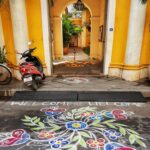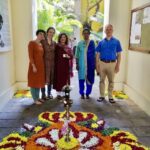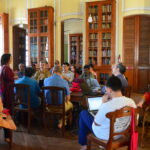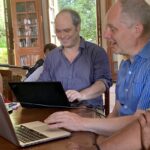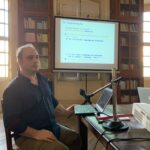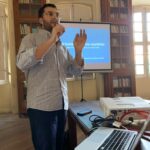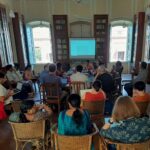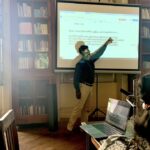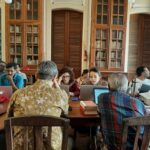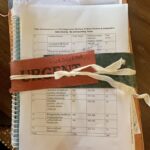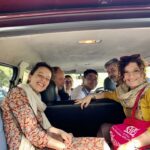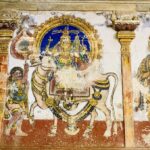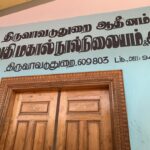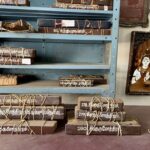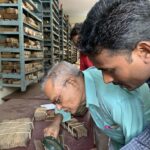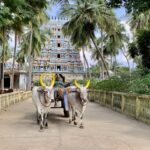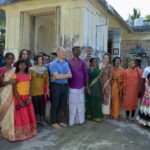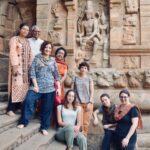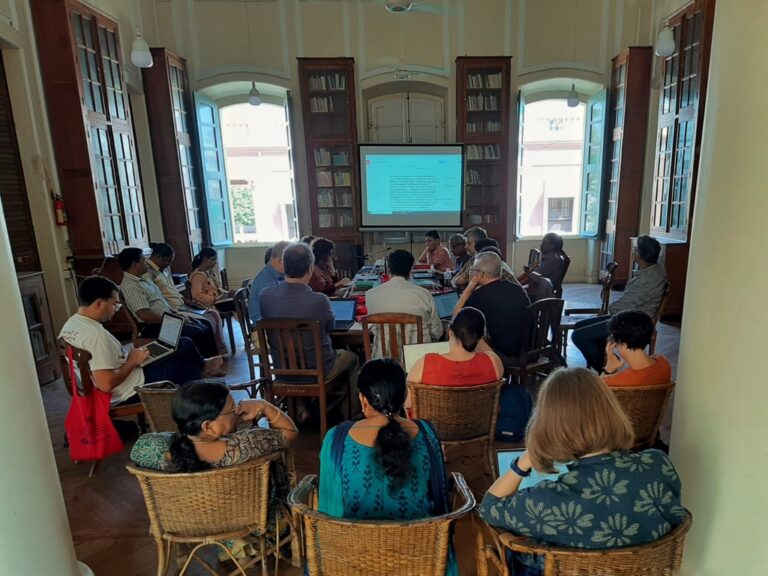
The “Pondicherry Workshop”, held at the EFEO Centre of Pondicherry from January 27th till February 7th, has been the first full-fledged reading workshop organized in the frame of the Śivadharma Project. This was a great opportunity for us all to present the materials on which the different teams are working, and to make good progress with the understanding of specific points. During this initial part of the project our work was in fact focused on the close reading of our textual sources, and so the classical formula of an intensive reading workshop was the most suitable option at this stage.
Readings were held every weekday in the mornings and afternoons. The mornings were mostly dedicated to our “contaminated” Sanskrit and Tamil readings of the Śivadharmottara and its 16th-century Tamil translation, the Civatarumōttaram. Our Naples-Pondicherry team has organized such readings on a weekly basis since March 2019, but for some attendees of the workshop this was the first time of having to alternate between the two languages and registers, and for people who are proficient in only one of these languages this was definitely challenging. Nonetheless, we appreciated how everyone tried to contribute to and learn from the readings. For this workshop we focused on the reading of chapter 2 (on the vidyādāna) and 10 (on the jñānayoga); Florinda De Simini and Dominic Goodall provided editions of the Sanskrit text, while Margherita Trento and T. Rajarethinam worked on translations from the Tamil text of the two chapters. The Tamil readings were partly conducted in the light of the 16th-century Tamil commentary on this translation, and of the compendium of the Civatarumōttaram contained in the 18th-century Taṇikaippurāṇam. Translations from this text were presented by K. Nachimuthu.
The Sanskrit editions are already at a relatively advanced stage, but our understanding of the text is now being enriched by the reading of the anonymous Śivadharmavivaraṇa, the Sanskrit commentary that SAS Sarma and Csaba Dezso are now transcribing from a manuscript in Malayalam script. This commentary, so far the only surviving one in Sanskrit that we know of, is not as detailed as one would wish, but at the same time it is proving useful to the interpretation of some points, and its text is showing important textual and cultural connections with the Southern transmission of the Śivadharmottara. Its study can thus add insights on lay Śaiva practice in the South. We still have no clues to the dating of this text.
Afternoons were devoted to purely Sanskritic readings, and thus we alternated sessions on the Vṛṣasārasaṃgraha, conducted by Csaba Kiss, with sessions on the Umāmaheśvarasaṃvāda of the Śivadharma Corpus and the Mahābhārata, conducted by Nirajan Kafle and Kenji Takahashi. The readings from the Vṛṣasārasaṃgraha, on the topic of the internalization of rituals (the anarthayajña), highlighted the difficult state of preservation of this text, whose puzzling grammatical and syntactical choices and corrupted variant readings are giving Csaba more than one headache. Nirajan and Kenji focused on the topic of gleaning, a practice prescribed for certain categories of renunciants who can only eat leftovers. Kenji has presented different passages on this topic from the Umāmaheśvarasaṃvāda(s) contained in the Anuśāsanaparvan of the Mahābhārata, in the framework of his investigations between the possible connections existing between this and the Umāmaheśvarasaṃvāda in the Śivadharma corpus.
Also, the two Ph.D. students, G. Venkataraman and Sushmita Das, got the chance to participate and lead a session on their edition from the Bṛhatkālottara.
Two lectures were held during the workshop: Csaba Kiss gave a talk titled ““…Not satisfied with the Mahābhārata” (śrutvā bhāratasaṃhitām atṛptaḥ): theVṛṣasārasaṃgraha’s role in the Śivadharma corpus” during the first week, while in the second week we attended Alessandro Battistini’s lecture, titled “Royal hunts and divine courtship: An overview of Sanskrit Śaiva Kāvya in South India”.
One of the issues we started to address during the workshop is that of the online format of our critical editions. Thanks to the expertise of Csaba Kiss, we are working on a “pilot” model that allows us a minimal markup of the text, so that it stays legible and easy to manage, and gets then visualized in an internet browser through a Python script that Csaba has devised.
The last two days of the workshop were not spent reading texts in the library of the EFEO, but researching manuscripts in the library of the Thiruvavaduthurai Adheenam (Tiruvāvaṭutuṟai Ātīṉam). This is an important Śaiva monastery that has been especially influential and rich in the 19th and at the beginning of the 20th century. It now maintains, among other things, a manuscript library and a publishing house. The manuscript library holds a great collection of texts both in Sanskrit and in Tamil, part of which has already been digitized by the EFEO, also through the ERC-Project “Nettamil”. However, several works still remain to be digitized. Given the nature of this institution, they do possess a relevant number of manuscripts of Śaiva works, and thanks to the efforts of scholars of the Śivadharma Project we were able to identify six still unknown Civatarumōttaram manuscripts. Our plan is to digitize them, along with other Śaiva works that are held in the library, and thus complete the digitization process that has been started by other projects.
The trip to Thiruvavaduthurai was a great way to end our workshop, and gave us the opportunity to visit important sites nearby, such as Suryanar Kovil; on the way back to Pondicherry, some team members stopped to visit the great Śaiva temple from Cōla times at Gaṅgaikondacolapuram.

